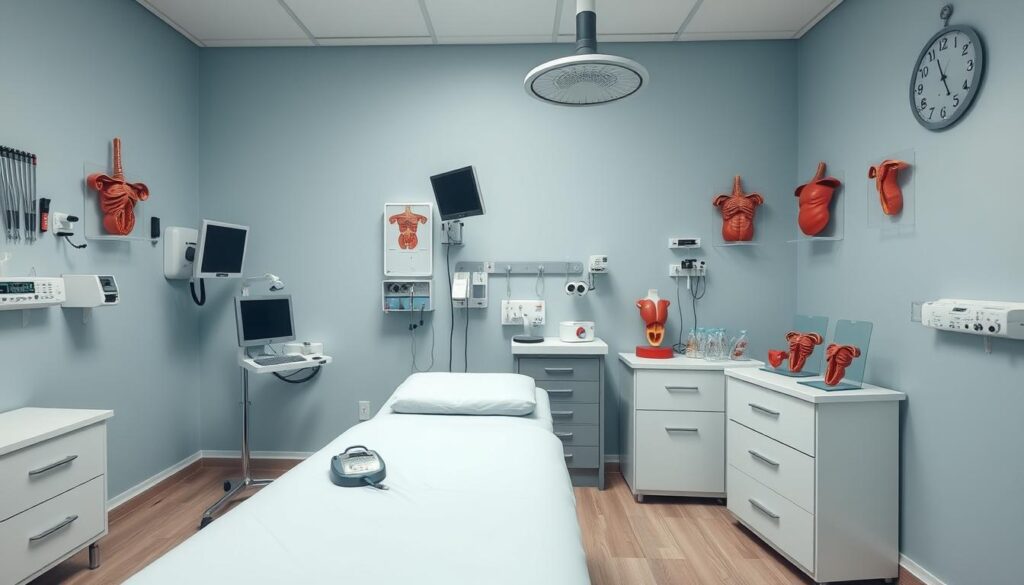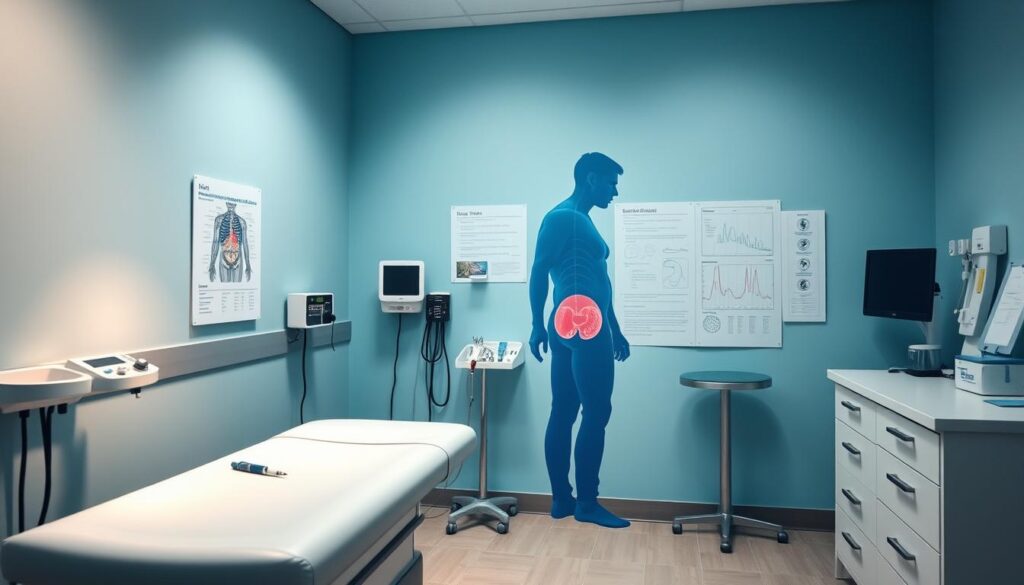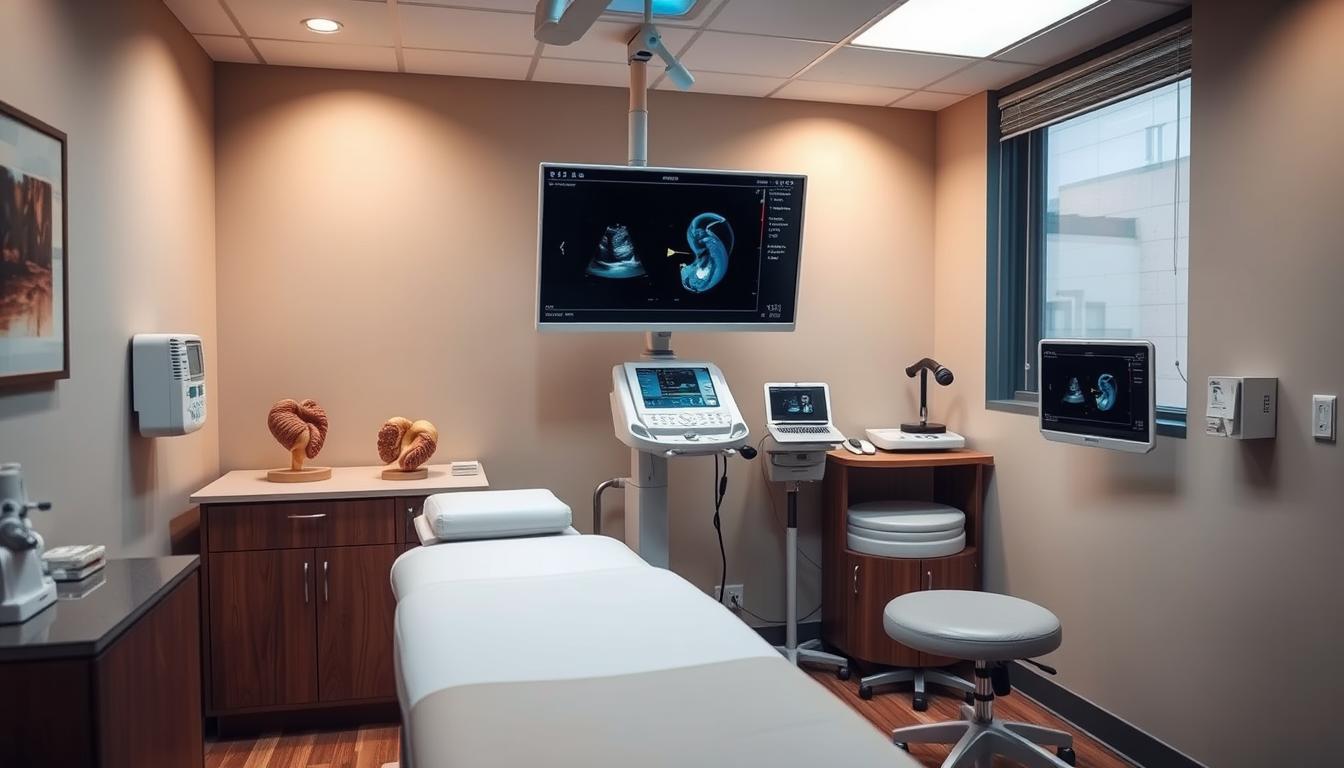Prostate cancer is the most common nonskin cancer among men in the United States1. About one out of every eight men in the United States will be diagnosed with prostate cancer1. This makes prostate screening very important for keeping your prostate healthy.
The risk of prostate cancer goes up after the age of 502. Black individuals face a higher risk of developing and dying from prostate cancer compared to other racial groups2. Early detection through prostate cancer screening is key. It's important to know the benefits and risks of screening for prostate health.
Early detection is crucial for treating prostate cancer. Regular prostate exams are vital for your prostate health and men's health14.
 Talking with your healthcare provider about the PSA test's benefits, limits, and risks is vital. This helps you make a smart choice about prostate cancer screening18. By knowing your PSA test results and your own risk factors, you can take care of your prostate health.
Talking with your healthcare provider about the PSA test's benefits, limits, and risks is vital. This helps you make a smart choice about prostate cancer screening18. By knowing your PSA test results and your own risk factors, you can take care of your prostate health.

Remember, insurance coverage and cost considerations can differ based on where you live and your insurance. About 51.2% of men got PSA tests over three years29. Knowing your options can help you make smart choices about your prostate screening and cost considerations.
Key Takeaways
- Prostate cancer is a common nonskin cancer among men in the United States1.
- Prostate screening can help detect prostate cancer early, increasing the chances of successful treatment2.
- Black individuals have a higher risk of developing and dying from prostate cancer compared to other racial groups2.
- Prostate cancer screening is essential for maintaining prostate health and can help find prostate cancer early, when treatment is most effective.
- Understanding the benefits and risks associated with prostate cancer screening is crucial for making informed decisions about prostate health.
- Prostate cancer causes more deaths in men than any other cancer except lung cancer1.
- Most men diagnosed with prostate cancer do not die from it1.
Understanding Prostate Screening and Its Importance
Prostate screening is key to keeping your prostate healthy. It usually includes a prostate-specific antigen (PSA) test and a digital rectal exam (DRE)3. These tests find prostate cancer early, which is vital for treatment. The National Center for Chronic Disease Prevention and Health Promotion says PSA tests and DREs are main tools for finding prostate cancer4. Regular prostate exam and psa test are very important. They help find and treat prostate cancer early3. But, it's also important to know the downsides, like false positives that cause worry and more tests3. Other things can also affect your risk of prostate cancer, like age, family history, and race3. For example, African Americans face a higher risk of prostate cancer at a younger age and more severe cases3. Regular screening can spot these risks early and help treat them quickly.Who Should Consider Prostate Screening
Prostate health is vital for men, and regular check-ups can spot problems early5. The US Preventive Services Task Force suggests that men aged 55 to 69 talk to their doctor about screening5. This talk is crucial for men's health, as it decides the best action for prostate care. Men at higher risk for prostate cancer, like African American men, should talk to their doctor about screening6. Also, men with a family history of prostate cancer should think about getting screened7. Regular check-ups can find issues early, which is key for effective treatment and keeping prostate health good. Men should make their prostate health a priority and get regular check-ups as part of their health routine5. This way, they can lower the risk of prostate cancer and stay healthy. Here are some important points to remember:- Men between 55 and 69 years old should discuss prostate cancer screening with their doctor5
- Men at increased risk, such as African American men, should discuss screening options with their doctor6
- Routine check-ups are essential for maintaining good prostate health and detecting potential issues early on7
| Age Group | Recommendation |
|---|---|
| 55-69 years old | Discuss prostate cancer screening with doctor5 |
| African American men | Discuss screening options with doctor6 |
| Men with family history | Consider screening7 |
Different Types of Prostate Screening Methods
Prostate screening is key for catching cancer early. There are several ways to screen, like the digital rectal exam, PSA test, and newer tech. A digital rectal exam lets a doctor feel the prostate for any oddities8. The PSA test checks blood for prostate-specific antigen, which can be high in cancer cases9. Newer tech like MRI and CT scans give clearer views of the prostate. This helps spot cancer better10. But, the PSA test can sometimes show false results, leading to more tests8. Always talk to a doctor about any risks before starting a test. Here are some things to think about when picking a screening method:- Digital rectal exam: a procedure where a doctor feels the prostate gland for any abnormalities8
- Prostate-specific antigen test: measures the level of PSA in the blood, which can be elevated in men with prostate cancer9
- Advanced screening technologies: such as MRI and CT scans, can provide more detailed images of the prostate gland and help diagnose prostate cancer10
| Screening Method | Description |
|---|---|
| Digital Rectal Exam | A procedure where a doctor feels the prostate gland for any abnormalities8 |
| Prostate-Specific Antigen Test | Measures the level of PSA in the blood, which can be elevated in men with prostate cancer9 |
| Advanced Screening Technologies | Such as MRI and CT scans, can provide more detailed images of the prostate gland and help diagnose prostate cancer10 |
When to Start Your Prostate Screening Journey
Prostate cancer is a big problem, affecting one in eight men11. It's vital to start screening early. The American Cancer Society says men should talk to their doctor about screening at 5012. But, if you're African American or have a family history, you might need to start at 4513. Early detection is key to beating prostate cancer. If caught early, the survival rate is about 99%12. You can screen with a Digital Rectal Exam (DRE) or the Prostate-Specific Antigen (PSA) test11. Always talk to your doctor about the pros and cons to decide what's best for you. Here are some key points to consider when starting your prostate screening journey:- Start discussing screening with your doctor at age 50 if you have an average risk of prostate cancer12
- Consider screening at age 45 if you are at higher risk13
- Early detection can cure prostate cancer in 90% of cases11
- Prostate cancer is the second-leading cause of cancer deaths among men in the U.S12.
| Age | Risk Level | Recommended Screening |
|---|---|---|
| 50 | Average | Discuss screening with doctor12 |
| 45 | Higher | Consider screening13 |
Preparing for Your Prostate Screening Appointment
Getting ready for your prostate screening is important. It's about your prostate health and men's health. The Mayo Clinic says talking about your health history with your doctor is key14. You might need to wait 48 hours without sex or ejaculation for the test. This helps get accurate results15. Also, tell your doctor about any health issues like hemorrhoids. This makes the exam more comfortable15. Here are some important things to remember for your prostate screening:- Discuss your medical history with your doctor
- Abstain from sex and ejaculation for 48 hours before the exam
- Inform your provider about any existing conditions
| Age | Recommendation |
|---|---|
| 40 | Start regular PSA testing if you're at high risk |
| 45 | Have a baseline PSA test if you're not at high risk |
| 50 | Have your first prostate exam |
Understanding PSA Test Results
When you get your psa test results, it's key to know what the numbers mean. The prostate-specific antigen (PSA) test checks the PSA in your blood. Levels usually go up with age in healthy men because of normal prostate work17. A PSA level over 4.0 ng/mL might suggest prostate cancer, but it's not a sure sign17. The American Urological Association suggests psa testing for men aged 55-69 at average risk, 40-54 with family history or Black individuals, and over 70 after talking with a doctor17. It's important to look at PSA levels with other risk factors. Always talk about them with your healthcare provider18. Here are some key points to consider when understanding your PSA test results:- PSA levels can be high due to both prostate cancer and noncancerous conditions. This makes the PSA test a screening tool, not a definitive test for prostate cancer18.
- False-positive results from the PSA test can cause worry and extra tests, like biopsies. These can lead to pain, bleeding, and infection18.
- New tests, like PSA velocity, percentage of free PSA, and PSA density, are being studied to improve prostate cancer screening18.
 Talking with your healthcare provider about the PSA test's benefits, limits, and risks is vital. This helps you make a smart choice about prostate cancer screening18. By knowing your PSA test results and your own risk factors, you can take care of your prostate health.
Talking with your healthcare provider about the PSA test's benefits, limits, and risks is vital. This helps you make a smart choice about prostate cancer screening18. By knowing your PSA test results and your own risk factors, you can take care of your prostate health.
Risk Factors That May Affect Your Screening Schedule
Understanding the risk factors for prostate health is key for men's health. A routine check-up can spot issues early. Some factors raise the chance of getting prostate cancer. For example, a family history of prostate cancer can double a man's risk19. Lifestyle choices, like a high-fat diet and obesity, also increase prostate cancer risk20. Age is another big factor, with more cases in men over 6520. Talking to your doctor about these risks helps plan your prostate health and check-ups. Important risk factors include:- Family history of prostate cancer
- Lifestyle factors, such as diet and obesity
- Age-related risks, particularly in men over 65
Common Myths About Prostate Screening
Prostate screening is key to catching prostate cancer early. Yet, some men skip it because of wrong ideas about the tests or the disease22. The National Center for Chronic Disease Prevention and Health Promotion says some men don't get screened because of these misconceptions. Prostate cancer is the top cancer in American men and the second biggest killer23. Early screening can boost survival chances to 97.5% in five years23. Some myths say screening is only for older men or that the PSA test is always right24. But, prostate cancer can hit any age, and the PSA test is just one way to find it. The National Cancer Institute notes African American men are twice as likely to die from it as white men23. It's vital to know the truth about screening's benefits and risks. Here are some key facts to consider:- PSA screening cuts the risk of dying from prostate cancer22.
- Prostate cancer is the most common form of cancer for American men and the second leading cause of cancer deaths23.
- A decent percentage of men in their thirties and forties have prostate cancer, even if they don't know it24.
Potential Benefits and Limitations of Regular Screening
Regular prostate screening can help men's health a lot. It can find prostate cancer early21. The Mayo Clinic says it can catch cancer when it's easiest to treat25. But, it's important to know the downsides, like false positives and overdiagnosis26. The American Urological Association suggests screening every two years for men 55 to 6925. Those with a family history of prostate cancer or are African-American might need more tests25. Regular checks can greatly lower the risk of dying from prostate cancer, as shown in the ERSPC study26. But, there are downsides too, like overdiagnosis and overtreatment26. It's key for men to talk to their doctor about the pros and cons. This way, they can make a smart choice about their prostate health21.| Age Group | Screening Recommendation |
|---|---|
| 55-69 | Every 2 years |
| 70 and older | Individualized decision |

Follow-Up Care and Next Steps
After prostate cancer screening, it's key to know what comes next. This screening is vital for catching cancer early. The National Cancer Institute says men with abnormal PSA test results might need more tests, like biopsies, to check for cancer27. After treatment, you'll see your doctor every 3 to 6 months for the first 5 years. Then, it's once a year27. Your doctor will check your PSA levels and do digital rectal exams. They'll also talk about any symptoms or worries you have. It's important to see your PSA levels drop a lot after treatment. They should be very low or not detectable within 2 months after surgery27. At times, you might need more tests, like CT scans or MRIs, if your PSA levels go up27. Working with your doctor to plan your follow-up care is crucial. This way, you can help manage your health and lower the chance of cancer coming back.- Monitoring PSA levels regularly
- Performing digital rectal examinations
- Discussing any symptoms or concerns with your healthcare provider
- Undergoing additional testing, such as imaging tests, if necessary
Insurance Coverage and Cost Considerations
Understanding your insurance coverage and cost considerations for prostate screening is key. Many health insurance plans cover tests like the PSA test and digital rectal exam28. But, it's important to check with your insurance to see what's covered. The American Cancer Society says many states require private insurers to cover these tests28. The cost of prostate screening can vary. In 2009, the national Medicare program spent $447 million on these tests29. The cost per person ranged from $17 to $6229. Knowing these costs can help you plan for your prostate screening.| Cost Category | Estimated Cost |
|---|---|
| PSA test | $10-$30 |
| Digital rectal exam | $20-$50 |
| Biopsy | $500-$1,000 |
Conclusion: Taking Control of Your Prostate Health
Your prostate health is in your hands. As a man, it's important to take an active role in prostate screening. This is key to keeping yourself healthy. You can work with your healthcare provider to understand your30 risk factors, like age and family history. Together, you can create a screening plan that's right for you31. Regular check-ups have their benefits and limitations. But they can help find30 problems early, when they're easier to treat. By being informed and proactive, you can manage your3130 prostate health. This way, you can look forward to a brighter, healthier future. Remember, your health is your most valuable asset. Start by talking to your doctor about your30 prostate screening options. Working together, you can tackle this journey and focus on your diet and well-being at every step.FAQ
What is prostate screening?
Prostate screening is key for your prostate health. It includes tests like the PSA test and digital rectal exam (DRE). These help find prostate cancer and other issues early.
Why is regular prostate screening important?
It's vital because it catches prostate cancer early. Early detection means better treatment chances and health outcomes.
What are the key benefits of early prostate cancer detection?
Early detection offers better treatment options and quality of life. It also means higher survival rates. Early stages avoid more invasive treatments and reduce complications.
Who should consider prostate screening?
Men over 50 and those with a family history of prostate cancer should get screened. Talk to your doctor about your risk factors to set up a screening schedule.
What are the different types of prostate screening methods?
Main methods include the digital rectal exam (DRE) and the prostate-specific antigen (PSA) test. Advanced tests like multiparametric MRI and genomic tests are also used.
When should I start my prostate screening journey?
Start screening around 50, or earlier if you have risk factors. Your doctor will decide the best age for you.
How can I prepare for my prostate screening appointment?
Share your medical history and any medications with your doctor. You might need to follow dietary or medication restrictions. Be open about any symptoms or concerns.
How do I interpret my PSA test results?
PSA results can be complex. A level over 4 ng/mL might need more testing. Your doctor will help understand your results and what to do next.
What risk factors can affect my prostate screening schedule?
Family history, lifestyle, and age can change your risk. Discuss these with your doctor to get the right screening plan.
What are some common myths about prostate screening?
Some myths say screening is unnecessary or always painful. It's important to know the facts and benefits of screening.
What are the potential benefits and limitations of regular prostate screening?
Benefits include early cancer detection and better treatment options. But, there are risks like false positives and overdiagnosis.
What happens after my prostate screening appointment?
Your doctor will review your results and plan next steps. This might include more tests or specialist referrals. Always follow up with your doctor.
How does insurance coverage and cost affect prostate screening?
Insurance often covers prostate screening, like the PSA test. Check with your provider to understand your coverage and costs.

[…] Screening guidelines recommend starting at age 40 for high-risk men2 […]
[…] cancer affects about 1 in 8 men over their lifetime2. It's vital for men to know about early detection and screening. Taking care of prostate health is important for men's overall well-being. Knowing about prostate […]